
Sassafras is a genus of three extant and one extinct species of deciduous trees in the family Lauraceae, native to eastern North America and eastern Asia. The genus is distinguished by its aromatic properties, which have made the tree useful to humans.

Viburnum lentago, the nannyberry, sheepberry, or sweet viburnum, is a species of Viburnum native to North America.

Sambucus is a genus of flowering plants in the family Adoxaceae. The various species are commonly called elder or elderberry. The genus was formerly placed in the honeysuckle family, Caprifoliaceae, but was reclassified as Adoxaceae due to genetic and morphological comparisons to plants in the genus Adoxa.
Ironwood is a common name for many woods or plants that have a reputation for hardness, or specifically a wood density that is heavier than water, although usage of the name ironwood in English may or may not indicate a tree that yields such heavy wood.
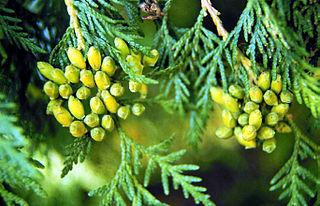
Thuja occidentalis, also known as northern white cedar, eastern white cedar, or arborvitae, is an evergreen coniferous tree, in the cypress family Cupressaceae, which is native to eastern Canada and much of the northcentral and northeastern United States. It is widely cultivated as an ornamental plant.

Magnolia grandiflora, commonly known as the southern magnolia or bull bay, is a tree of the family Magnoliaceae native to the southeastern United States, from Virginia to central Florida, and west to East Texas. Reaching 27.5 m (90 ft) in height, it is a large, striking evergreen tree, with large dark green leaves up to 20 cm long and 12 cm wide, and large, white, fragrant flowers up to 30 cm (12 in) in diameter.

Cladium is a genus of large sedges, with a nearly worldwide distribution in tropical and temperate regions. These are plants characterized by long, narrow (grass-like) leaves having sharp, often serrated (sawtooth-like) margins, and flowering stems 1–3 m tall bearing a much-branched inflorescence. Like many plants found in wet habitats, it has deeply buried rhizomes that can produce tall shoots with dense canopies.
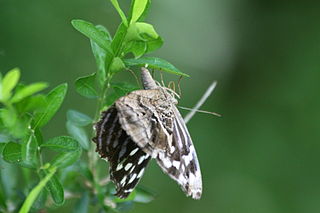
Adelia is a genus of flowering plants in the spurge family, Euphorbiaceae, subfamily Acalyphoideae. It is native to Latin America and the Caribbean, with one species extending northward into the southernmost part of Texas.

Abies lasiocarpa, the subalpine fir or Rocky Mountain fir, is a western North American fir tree.
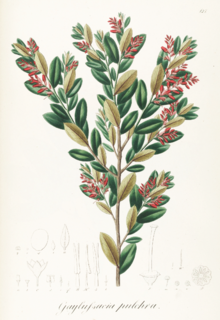
Gaylussacia is a genus of about fifty species of flowering plants in the family Ericaceae, native to the Americas, where they occur in eastern North America and in South America in the Andes and the mountains of southeastern Brazil. Common English names include huckleberry and "dangleberry".

Hydrangea cinerea, the ashy hydrangea or gray hydrangea, is a small to medium sized, deciduous shrub up to 3 m tall; its natural range is interior regions of the southeastern United States. Its common names reflect the ashy or gray appearance of the undersides of its leaves, which results from a dense pubescence.

Forestiera is a genus of flowering plants in the olive family, Oleaceae. Members of the genus are often called swampprivets. Most are shrubs.

Forestiera acuminata, commonly known as eastern swamp privet, is a deciduous shrub or small tree that is native to the southeastern and central United States, growing primarily in or near wetlands. It is especially common along the Mississippi Valley as far north as Illinois and Indiana, but found also across the South from eastern Texas to South Carolina.

Forestiera pubescens, commonly known as stretchberry, desert olive, tanglewood, devil's elbow, spring goldenglow, spring herald, New Mexico privet, or Texas forsythia is a deciduous shrub or small tree native to the southwestern United States and northern Mexico.

Commelina diffusa, sometimes known as the climbing dayflower or spreading dayflower, is a pantropical herbaceous plant in the dayflower family. It has been introduced to the southeastern United States where it is most common in wet disturbed soils. There are two recognised varieties, one being the type and the other being C. diffusa var. gigas, which is native to Asia and has been introduced to Florida. It flowers from spring to fall and is most common in disturbed situations, moist places and forests. In China the plant is used medicinally as a febrifuge and a diuretic. A blue dye is also extracted from the flower for paints. In the Hawaiian Islands, it is known as "honohono grass", although it is technically not a grass. "Honohono" refers to the alternating structure of the leaves. At least one publication lists it as an edible plant in New Guinea.

Packera paupercula is a flowering plant species of the genus Packera and family Asteraceae, native to North America, where it is widespread across Canada and much of the United States. Its common names include balsam ragwort and balsam groundsel.
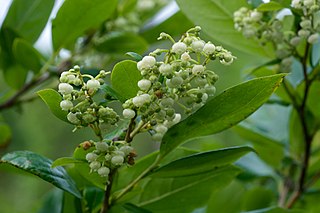
Lyonia ligustrina is a species of flowering plant in the family Ericaceae known by the common names maleberry and he-huckleberry. It is native to the eastern United States from Maine to Florida and west to Texas and Oklahoma.

Vaccinium myrsinites is a species of flowering plant in the heath family known by the common name shiny blueberry. It is native to the southeastern United States from Alabama, Georgia, South Carolina and Florida. It may occur as far west as Louisiana.
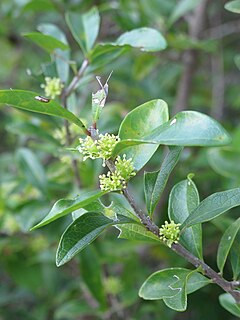
Forestiera segregata is a species of flowering plant in the olive family known by the common names Florida privet, Florida swampprivet, and southern privet. It is native to the Bahamas, the Greater Antilles, including Puerto Rico and the Cayman Islands, the Lesser Antilles, including Anguilla, and Florida, Georgia, and South Carolina in the United States.

Nyssa biflora, commonly referred to as the swamp tupelo, or swamp black-gum is a species of tupelo that lives in wetland habitats. Swamp tupelo grows chiefly in the coastal plains from Delaware, eastern Maryland, and southeastern Virginia, south to southern Florida and west to eastern Texas. Its range extends north up the Mississippi Valley to southern Arkansas and west and south Tennessee.



















